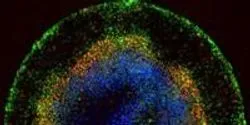Biological Sciences

About seven days after conception, something remarkable occurs in the clump of cells that will eventually become a new human being. They start to specialize. They take on characteristics that begin to hint at their ultimate fate as part of the skin, brain, muscle or any of the roughly 200 cell types that exist in people, and they start to form distinct layers.

Bacteria are a pervasive and elusive bunch. Scientists estimate that between 10 million and 1 billion different microbial species populate the world, yet only a handful of them have so far been identified. Why? Because the overwhelming majority of microbes refuse to grow in the laboratory. This is despite decades of scientists’ best efforts at coaxing the microscopic organisms into action.

Researchers at the University of California, San Diego School of Medicine have discovered a widely distributed group of marine bacteria that produce compounds nearly identical to toxic man-made fire retardants.

Kansas State University diagnosticians are helping the cattle industry save millions of dollars each year by developing earlier and accurate detection of E. coli.

Merck Millipore, the Life Science division of Merck, today (June 17) launched Simplicon™ RNA Reprogramming Technology, which uses synthetic self-replicating RNA to create large numbers of human induced pluripotent stem cells (iPSCs) using a single transfection step. This efficient reprogramming of somatic cells is accomplished without viral intermediates or host genome integration, offering a more defined and safer system for iPSC generation.

A new laboratory technique developed by Agricultural Research Service (ARS) scientists could speed the search for soybean plants with resistance to the fungus that causes Phomopsis seed decay (PSD) in the legume crop.

Much as human DNA can be used as evidence in criminal trials, genetic information about microorganisms can be analyzed to identify pathogens or other biological agents in the event of a suspicious disease outbreak. The tools and methods used to investigate such outbreaks belong to an emerging discipline known as microbial forensics, but the field faces substantial scientific and technical challenges, says a new report from the National Research Council.














